drivers ed
1/163
There's no tags or description
Looks like no tags are added yet.
Name | Mastery | Learn | Test | Matching | Spaced |
|---|
No study sessions yet.
164 Terms
Red light- what do you do
At a red light, come to a complete stop at the stop line or, if there is no stop line, before entering the intersection or before reaching the crosswalk. Remain stopped as long as the signal is red, unless turns are allowed.
Right turn on red- is it allowed?
You may turn right while the traffic signal displays a red light. Before turning, you must come to a complete stop. Look both ways and yield the right-of-way to pedestrians and other traffic. Be sure to check for less visible vehicles such as motorcycles, bicycles and mopeds. You may not turn right on red if signs are posted at the intersection that read "No Turn on Red," or if a red arrow pointing to the right is displayed.
Left turn on red-is it allowed and if what two things are present
You may turn left at a red light if you are on a one-way street and turning left onto another one-way street while the traffic signal displays a red light. Before turning, you must come to a complete stop. Look both ways and yield the right-of-way to pedestrians and other traffic. Be sure to check for less visible vehicles such as motorcycles, bicycles, and mopeds. You may not turn left on red if signs are posted at the intersection that read "No Turn on Red," or if a red arrow pointing to the left is displayed.
Red arrow- what does it mean
A red arrow means you must stop if you intend to move in the direction of the arrow. You may not proceed in the direction of the arrow as long as the red arrow is displayed, unless signs are posted at the intersection that read "Right on Red Arrow After Stop" or "Left on Red Arrow After Stop." Virginia law prohibits right and left turns at red arrow lights.
Note: If you are traveling in another state, make sure you know its laws for right and left turns at red and red arrow lights.
Flashing red light-what do you do
At a flashing red light, come to a complete stop and yield to oncoming vehicles and pedestrians.
You may go when the way is clear. At a railroad crossing, you must come to a complete stop even if you don't see a train.
should you come to a complete stop at a railroad crossing even if you don’t see a train when there’s a flashing red light
yes
Flashing red arrow-what do you do
At a flashing red arrow, come to a complete stop, yield the right-of-way to vehicles coming from the other direction and pedestrians in the intersection, and proceed in the direction of the arrow when the way is clear.
Yellow light or arrow- what should you do?
If you have not entered the intersection, stop or, if unsafe to stop, cautiously go through it. If you are already in the intersection, go through it cautiously. Do not speed up to beat the light.
what does a yellow light or arrow mean
A yellow light or arrow are cautions warning that the light is about to change
Flashing yellow light-what does you do
A flashing yellow light means slow down and proceed with caution. Flashing yellow lights are at locations with higher-than-normal hazardous conditions.
Flashing yellow arrow-what do you do
At a flashing yellow arrow, you may turn in the direction of the arrow, if the way is clear. Yield the right-of-way to vehicles coming from the other direction and pedestrians in the intersection. Be sure to check for less visible vehicles such as motorcycles, bicycles, and mopeds. If a traffic light changes from red to flashing yellow arrow while a pedestrian is in the intersection, allow the pedestrian to cross the street before turning.
Green light or arrow-what do you do
At a green light, you may go if the way is clear. At a green arrow, you may go in the direction of the arrow if the way is clear. If you are turning without a green arrow, you must yield the right-of-way to vehicles coming from the other direction and pedestrians in the intersection. Be sure to check for less visible vehicles such as motorcycles, bicycles, and mopeds. If a traffic light changes from red to green while a pedestrian is in the street, allow the pedestrian to cross the street before turning.
what are out of service signals
When traffic signals are not working because of a power outage or other problem and not displaying any lights
what do you do at an out of service signal and when does this not apply
you are required to stop, proceeding through the intersection as though it were an all-way stop. This does not apply if a law enforcement officer or other authorized person is directing traffic at the intersection, or if portable stop signs are in use.
what do lane use signals signify
lanes where you can and cannot drive during different hours of the day
Never drive in a lane marked with a….
red x
These signals mean that you should move out of the lane as soon as safely possible…..
Yellow X or Yellow Diagonal Downward Arrow
You are permitted to drive in a lane marked with a…
green arrow
Left-turn Arrow:..
You are permitted to enter in a lane marked with a one-way or two-way arrow only to turn in the direction of the arrow.
Red is used to convey
stop, yield, do not, and no.
Black used with white is used to convey
Speed limit, do not pass, no turns
Yellow used with black conveys
warning
Green and white, blue and white, and brown and white
helpful info. stops, destination,etc.
Orange and black and pink and black are used for
dvise and warn in construction (orange) and incident (pink) areas. They are used with black and white signs that convey regulations that might exist only because of the construction effort or the incident.
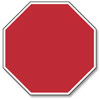
Octagon
stop
triangle
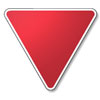
yield
rectangle
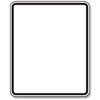
regulatory or guide
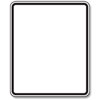
rectangle vertical

generally give instructions or tell you the law.
rectangle horizontal
may give directions or information.
diamond
warning
pentagon
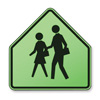
school crossing zone
Regulatory or guide signs
inform you of the law; you must obey their instructions.
Remember that a red circle with a slash means
no
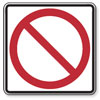
no….wtv is inside
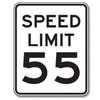
what the speed limit is
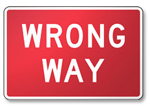

dont go that way
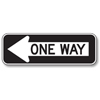

traffic flows only in that direction
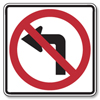
no left turns
in va u turns are considered….
two left turns and are illegal if a no left turn sign is there
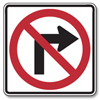
no right turns
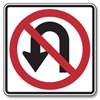
no u turns
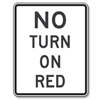
you may not turn on the red light. Wait for the signal to turn green.

This sign marks the beginning of a no passing zone. You may not pass cars ahead of you in your lane, even if the way is clear.

this sign is also with what
This sign is used with a traffic signal. It tells you that the traffic turning left at a green light does not have the right-of-way and must yield to traffic coming from the other direction. Stop and look for oncoming traffic, then proceed with caution.
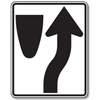
traffic island, median or barrier is ahead. Keep to the side indicated by the arrow.
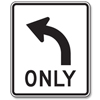
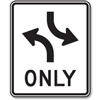
these signs are used when
where turns are required or where special turning movements are permitted for specific lanes. Traffic in the lane must turn in the direction of the arrow.

These signs indicate lanes reserved for buses and vehicles with a driver and one or more passengers as specified on the sign.
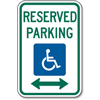
Parking spaces marked with these signs are reserved for people with disabled parking permits.
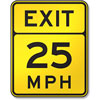
This sign indicates the maximum safe speed for a highway exit.
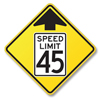
Reduced Speed Limit Ahead: Prepare to reduce your speed; the speed limit is changing ahead.


Stop Ahead/Yield Ahead: A stop sign or yield sign is ahead. Slow down and be ready to stop.
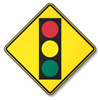
Signal Ahead: Traffic signals are ahead. Slow down and be ready to stop.

No Passing Zone: This sign marks the beginning of a no passing zone. You may not pass cars ahead of you in your lane, even if the way is clear.

Merge: Two lanes of traffic moving in the same direction are about to become one. Drivers in both lanes are responsible for merging safely.
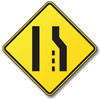
Lane Reduction: The right lane ends soon. Drivers in the right lane must merge left when space opens up. Drivers in the left lane should allow other vehicles to merge smoothly.
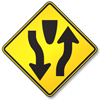
Divided Highway Begins: The highway ahead is split into two separate roadways by a median or divider and each roadway is one-way. Keep right.
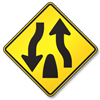
Divided Highway Ends: The highway ahead no longer has a median or divider. Traffic goes in both directions. Keep right.
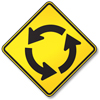
Roundabout: These signs indicate a circular intersection with an island in the center is ahead. Also called traffic circles, these intersections may have one or more lanes. Entering traffic must yield the right-of-way to traffic already in the circle and travel in a counter clockwise direction.
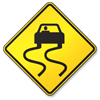
Slippery When Wet: When pavement is wet, reduce your speed. Do not brake hard or change direction suddenly. Increase the distance between your car and the one ahead of you.
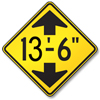
Low Clearance Sign: The overpass ahead has a low clearance. Do not proceed if your vehicle is taller than the height shown on the sign.
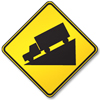
Hill: A steep grade is ahead. Check your brakes.
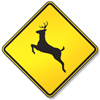
Deer Crossing: Deer cross the roadway in this area. Slow down, be alert and be ready to stop.
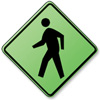

Pedestrian Crossing: Watch for people entering a crosswalk or crossing your path. Slow down and be prepared to stop. A second sign with an arrow may show the actual location of the crosswalk.

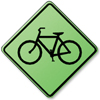
Bicycle Crossing/Bike Path: Bicycles regularly cross or ride beside traffic in this area. Drive with caution. A second sign with an arrow may show the actual location of the bike crossing.
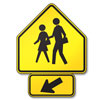
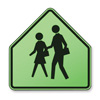
School Zone/School Crossing: Watch out for children crossing the street or playing. Be ready to slow down or stop. Obey speed limits and signals from any crossing guards. A second sign with an arrow may show the actual location of the sidewalk.
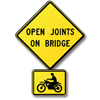
Open Joints: Slow down. Open joints on bridges or ramps could cause a motorcyclist to lose control of the motorcycle.
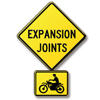
Expansion Joints: This sign is used when a joint across lanes creates a bump or is wide enough to cause loss of traction in wet weather.
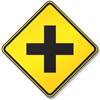

Intersections: An intersection is ahead. Be alert for vehicles entering the road on which you are traveling.
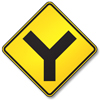
Y Intersection: You must bear either right or left ahead.
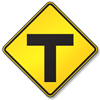
T Intersection: The roadway you are traveling on ends ahead at a stop sign. You must turn right or left after yielding to oncoming traffic and pedestrians
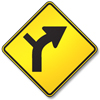
Right Curve – Side Road: The road ahead curves right and a side road joins from the left within the curve. Be alert for vehicles entering the roadway you are traveling on.
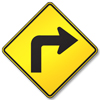
Sharp Right Turn: Slow down and be prepared for a sharp right turn in the road ahead.
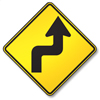
Sharp Right and Left Turns: Slow down and be prepared for the road ahead to turn sharply right, then left.
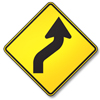
Right and Left Curves: The road ahead curves right, then left. Slow down.
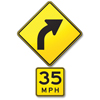
Right Curve with Safe Speed Indicator: The road ahead curves right. Slow down to the safe speed indicated.
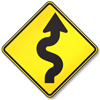
Winding Road: The road ahead winds with a series of turns or curves. On all curves, slow down for better control.
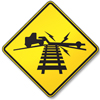
Low Ground Railroad Crossing: A steep slope where the railroad tracks cross the road may cause the bottom of low vehicles to get caught or drag on the tracks.
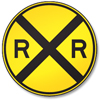
Railroad Crossing: Advance warning signs are placed before a railroad crossing. These signs warn you to look, listen, slow down and be prepared to stop for trains or any vehicles using the rails.
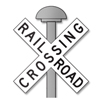
Railroad Crossbuck: This sign is a warning of a railroad crossing. Look, listen, slow down and be prepared to stop for trains or any vehicles using the rails. Trains may be approaching from either direction. If there is more than one track, trains may be approaching from either direction on either track.
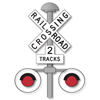
Railroad Crossbuck and Flashing Lights: Flashing lights may be used with crossbuck signs. Always stop when the light begins to flash and be alert for approaching trains. Do not proceed until all trains or any other vehicles using the rails have passed, the tracks are clear, and the lights are no longer flashing. Be especially alert at multi-track crossings because a second train could be approaching from the opposite direction.
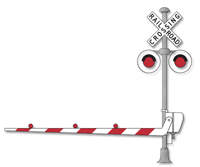
Crossbuck, Flashing Lights and Gate: Gates are used with flashing light signals at some crossings. Stop when the lights begin to flash and before the gate lowers. Remain stopped until the gates are raised and the lights stop flashing. Do not attempt to drive around the lowered gate.

Rough Road, Bump, or Uneven Lanes: These signs are used when certain road conditions, such as loose gravel or road construction, affect the roadway surface and create potentially difficult conditions for motorists, especially motorcyclists.
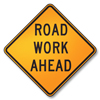
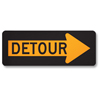
Road Construction Ahead – Detour: These signs indicate a change in the traffic pattern or route ahead. Slow down. Unusual or potentially dangerous conditions are ahead.

Flashing Arrow Boards: Large flashing arrow boards or flashing message signs in work zones direct drivers to proceed into different traffic lanes and inform them that part of the road ahead is closed.
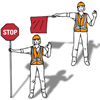
Flaggers: Flaggers are highway workers who normally wear orange or yellow vests, or yellow-green shirts or jackets. They use STOP/SLOW paddles or red flags to stop or direct traffic through the work zone and to let other workers or construction vehicles cross the road.
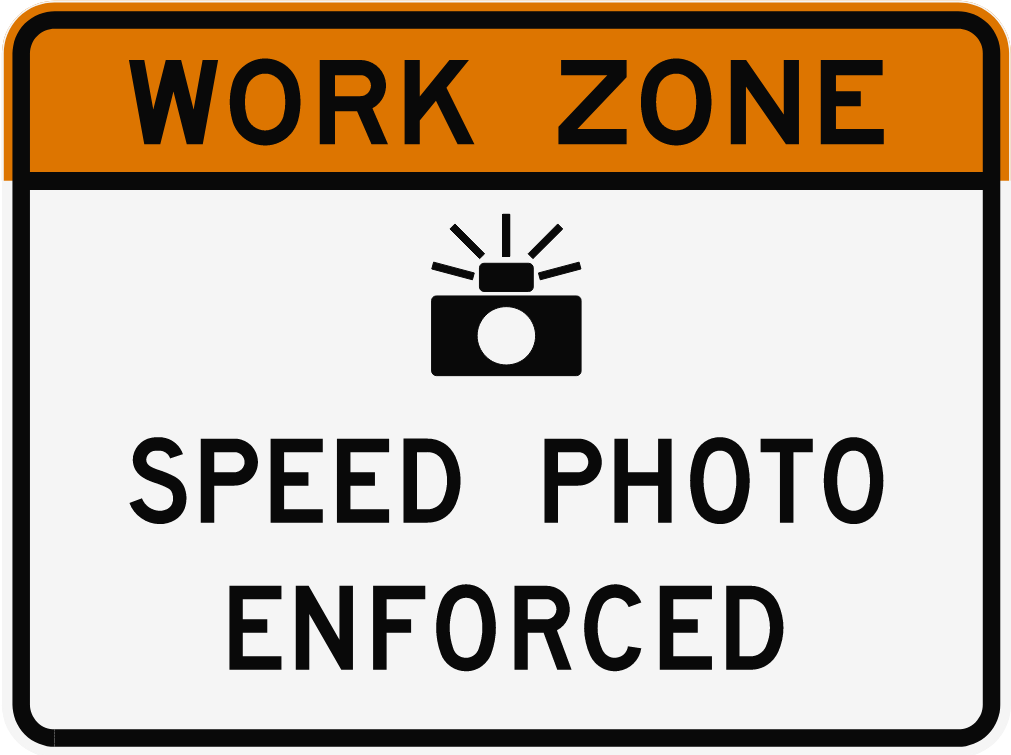
Photo Speed Enforcement: This sign indicates that automated photo enforcement is in place for speeding in a work zone. Always obey the posted speed limit in a work zone.
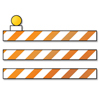

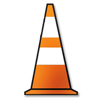
Traffic Control Devices: Barricades, vertical signs, concrete barriers, drums and cones are the most common devices used to guide drivers safely through work zones. When driving near the devices, keep your vehicle in the middle of the lane and obey the posted speed limit. As you leave the work zone, stay in your lane and maintain your speed. Don't change lanes until you are completely clear of the work zone.
Message Boards:
They provide information about traffic, road, weather or other hazardous conditions. Always obey any directions posted on these message boards.
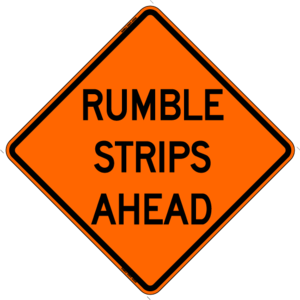
warn motorists black or orange strips placed across the travel lanes in advance of work zones, including a flagger or lane closure. Rumble strips should be driven over slowly, not swerved around. Rumble Strips Ahead signs warn motorists of black or orange strips placed across the travel lanes in advance of work zones, including a flagger or lane closure. Rumble strips should be driven over slowly, not swerved around.
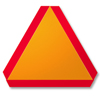
Slowing Moving Vehicles traveling at 25 mph or less, such as farm equipment, horse-drawn vehicles or highway work vehicles must display these signs when using a public highway. Be prepared to adjust your speed or position when you see a vehicle with one of these signs.
Red pavement markings
are generally not used; but, some communities do use red curbs to indicate no parking zones.
Red reflectors on the pavement show
show areas not to be entered or used. They are positioned on the road surface so that only traffic flowing in the wrong direction would observe them.
Yellow center lines mean
two-way traffic, flowing in opposite directions.
Broken yellow center lines mean
that passing on the left is allowed in either direction when the way ahead is clear.
A broken yellow line alongside a solid yellow line means that
passing is allowed from the side of the broken line, but not from the side of the solid line.
Double solid yellow lines mark
the center of the road and separate traffic traveling in two different directions. Passing is not allowed in either direction. You may not cross the lines unless you are making a left turn.
Broken white lines
separate lanes of traffic going in the same direction. You may change lanes with caution.
Solid white lines show
turning lanes and discourage lane changes near intersections, interchange/on- and off-ramps, and at other locations where lane changes might be dangerous. Solid white lines also mark the right edge of pavement. Arrows used with white lines indicate which turn may be made from the lane. Stop lines, crosswalks and parking spaces also are marked by white lines.
White lane arrows are…
curved or straight
If you are in a lane marked with a curved arrow or a curved arrow and the word ONLY, you must turn…..
in the direction of the arrow